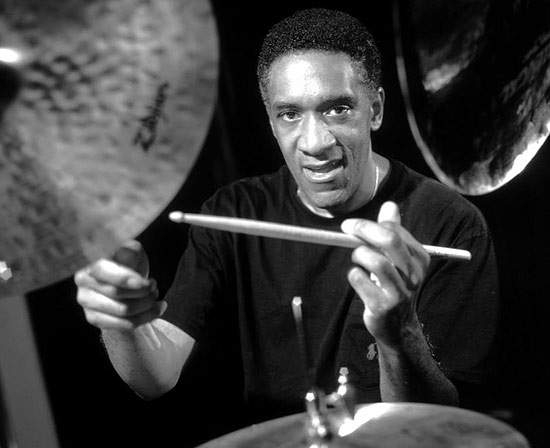Dive into the Power & Passion of ‘Tenor Madness
In the vast panorama of jazz, Sonny Rollins’ “Tenor…
The undulating rhythm of Joe Henderson‘s saxophone on “The State of the Tenor, Volume 2” is a pulse of life. It emanates a raw, spirited essence of jazz, simmering in tradition yet bubbling with innovation. This album, a magnetic blend of thought-provoking composition and freewheeling improvisation, represents jazz at its most authentic, crafted by the masters of the genre.

Recorded across the chilly nights of November 14-16, 1985, the album hums with the soul of the Village Vanguard, New York City’s celebrated jazz haven. Blue Note Records, a beacon for the genre, produced the album, continuing their tradition of nurturing avant-garde jazz music.
Henderson, a saxophonist par excellence, commanded the stage. Raised in Lima, Ohio, his style was an intricate tapestry woven with threads of soulful sophistication and a growling tenor that resonated deeply with his audience. By the time this album was recorded, Henderson had already secured his place in the pantheon of jazz greats. “The State of the Tenor, Volume 2” showcased him at his very best: vibrant, confident, and undeniably magnetic.

Ron Carter, the legendary bassist, needs no introduction. A veteran sideman of Miles Davis, Carter’s nimble fingers danced on the bass strings with precision and poise. His music was a subtle yet defining force that propelled the ensemble, amplifying Henderson’s melodic explorations with his rhythmic backbone.

Sharing the stage with Henderson and Carter was the equally captivating Al Foster. As a drummer, Foster was a maestro, his drums echoing the rhythm of the cosmos. An ex-Miles Davis sideman like Carter, Foster’s seamless blend of soft cymbal whispers and thunderous drum roars was the heartbeat of the trio’s music.

Prior to this session, the trio was deeply engaged in their individual pursuits. Henderson was marking a successful return from a four-year recording hiatus. Carter was enthralling audiences with his quartet, while Foster’s dynamic drumming was pushing the boundaries of jazz rhythm. When they came together for “The State of the Tenor, Volume 2”, it was a cosmic alignment of jazz giants.
“The State of the Tenor, Volume 2” dances into life with “Boo Boo’s Birthday,” a Thelonious Monk composition. Henderson takes Monk’s jagged melodies, exploring them through a series of winding improvisations over the rhythmic backdrop set by Carter and Foster.
“Y Ya La Quiero” stands out in its enchanting allure. Henderson’s saxophone serenades listeners with high fluttering tremolo, his avant-garde style melding with Carter’s fulcrum-like bass and Foster’s pulsing hi-hat figures. The soulful soundscape of “Soulville” showcases a mellow, swinging rendition of Horace Silver’s tune, while “The Bead Game” roars with a high-intensity post-bop approach.

The album is an exploration of avant-garde jazz, intertwined with melodic grace and rhythmic sophistication. It weaves together themes of joy, introspection, and boundless creativity, creating an unforgettable musical tapestry.
Upon its release, “The State of the Tenor, Volume 2” was lauded as a sonic marvel, garnering immense critical acclaim. It created ripples in the world of jazz, breathing new life into the genre while heralding a new era of innovation and experimentation.
Today, the album stands as a timeless masterpiece. It continues to resonate deeply with listeners, enchanting them with its emotional depth and technical prowess. Its enduring significance lies in its spirit of authenticity, its relentless pursuit of artistic freedom, and its testament to the prowess of its creators.
Emerging jazz musicians of today often cite Joe Henderson as a significant influence. Henderson’s maverick approach to the tenor saxophone is keenly studied and emulated, his ability to weave intricate narratives with his instrument has been a subject of much fascination. The ethos of exploration that “The State of the Tenor, Volume 2” embodies has inspired a new generation of jazz musicians to push boundaries and redefine norms. They’ve taken Henderson’s lessons to heart, capturing his adventurous spirit and channeling it into their own creative expressions.
Reflecting on the album, I can’t help but be struck by the magic of “Portrait,” a tune co-written by Horace Silver and jazz bass legend Charles Mingus. It’s not just a song; it’s an intimate conversation between Henderson and his instrument, imbued with tenderness and robust muscularity. To me, it represents the essence of “The State of the Tenor, Volume 2” – it’s intricate, nuanced, and emotionally charged, much like the album itself.
Looking back, “The State of the Tenor, Volume 2” was more than just an album – it was a declaration of jazz’s unending potential. It showcased the power of collaboration between titans of the genre and illustrated the dynamism that arises when great minds converge on a shared vision. It stands as a testament to the versatility of jazz, its capacity for evolution, and its resistance to stagnation.
In the pantheon of jazz albums, “The State of the Tenor, Volume 2” occupies a special place. It’s not just a musical endeavor, but a monumental chapter in the story of jazz. It encapsulates the spirit of an era, the genius of its creators, and the promise of its legacy. Its impact reverberates through the halls of jazz history, as vibrant and undeniable as the music it contains.
In conclusion, “The State of the Tenor, Volume 2” remains a beacon of jazz excellence. Its blend of tradition and innovation continues to inspire, and its raw, unfiltered expression of emotion continues to resonate. More than three decades after its release, it still stands as a testament to the timeless power of jazz, a power that Joe Henderson, Ron Carter, and Al Foster harnessed to create a masterpiece. It serves as a reminder of the limitless potential that exists when we dare to explore, to innovate, and to express our deepest emotions through music. For this reason and more, it remains an indispensable part of any jazz lover’s collection.